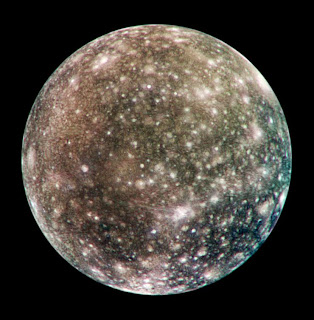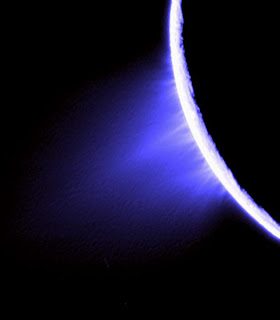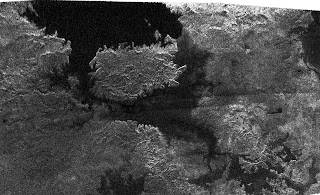Jupiter is the biggest planet of the Solar System, it is more than 1000 times bigger than Earth. Its four bigger moons were discovered by Galileu Galilei in 1610, the are (in orbital order): Io, Europa, Ganimedes and Calisto. These moons are so big that if they had its own orbit around the Sun they would be consider as planets.
 |
| Galilean Moons, the Earth and the Moon (in scale). |
Io
Io is the closest moon to Jupiter, because of that it is highly influenced by the jovian gravity, just like the Earth is influenced by the Moon's gravity. Here, on Earth, the Moon's influence causes the tides in the sea. On Io instead of water, the tides are made of soil. Jupiter's influence is so hard that it changes Io's diameter in about 100 meters. This process generates heat inside Io and produces huge vulcanos around its surface. The yellow color of Io is due to the sulfur and sulfur dioxide produced by the vulcanic activity. See the images below:
 |
| Io with a huge red spot caused by an eruption. |
 |
| Io's surface. The black dots are very big vulcanos. |
Europa
Europa is the most incredible moon of Jupiter, it is all covered by ice and because of Jupiter's gravity there's heat inside of it, the heat melt the ice and creates a "planetary" ocean underground. We can see the Jupiter's influence in the huge cracks of Europa's surface, some of than are more than one hundred miles long. Europa and Mars are the very best places to search for extraterrestrial life in our Solar System. In fact, there is two times more water on Europa then on Earth. See the images below:
 |
| Europa (image created with photos taken by the Galileo probe). |
Ganymede is the biggest moon of Jupiter, it is bigger than the planet Mercury. Its surface is composed by water ice and dust. Although it is more distant from Jupiter, Ganymede is also influenced by Jupiter's gravity and probably it also has a big ocean underground.
 |
| Photo of Ganymede taken by the Voyager 1 probe. |
 |
| Photo of Ganymede taken by the Galileu probe. |
Calixto
Calixto is the farther moon of Jupiter and the second largest. There is a lot of craters on its surface and, as Ganymede, it is composed by ice water and dust, and possibly there is liquid water on its subsoil.
 |
| Photo of Calixto taken by the Galileu probe. |
 |
| Photo of Calixto taken by the Voyager 1 probe. |



















